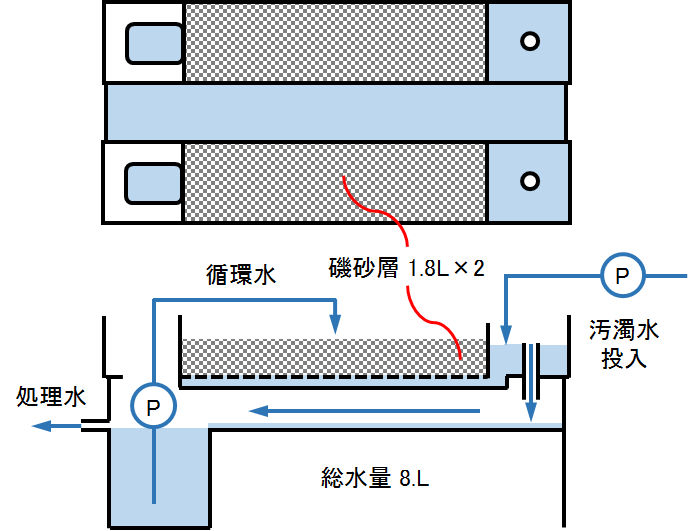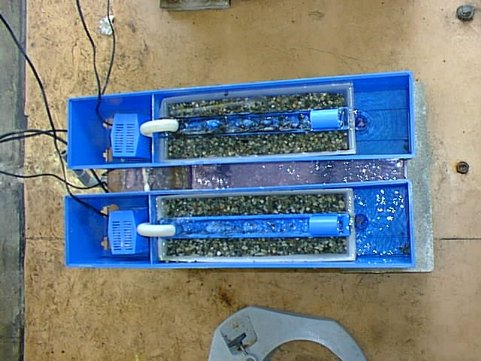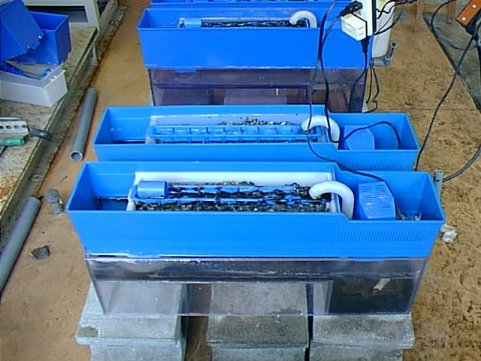Biofiter(2) – Persistent industrial organic wastewater
村上定瞭(水浄化フォーラム), Sadaaki Murakami (Water & Solutions Forum)
Functions and Features, Reaction Tank
Bio-carrier and Selection
Application Fields and Examples
Ⅱ. Experimental and Understanding of Biofilm Process
1. Ornamental Fish Aquarium
2. Persistent Industrial Organic Wastewater (this page)
ここで紹介する実験方法及び装置は、鑑賞魚水槽の生物ろ過装置を応用したもので、次のような特徴がある。
1) 排水中の汚濁物質が生物で分解できるかどうか。可能であれば、その処理工程の設計上の知見が得られる。
2) スケールアップした生物処理工程に用いる微生物を育種できる。
3) 当該する工場排水のBOD測定の植種用微生物を培養・保持ができる。
4) この実験装置の維持管理は極めて容易である。
The experimental method and device explained here are an application of the biological filtration device of the ornamental fish aquarium, and have the following features.
1) Whether pollutants in wastewater can be decomposed by organisms. If possible, knowledge on the design of the treatment process will be obtained.
2) Can breed microorganisms used in scale-up biological treatment processes.
3) It is possible to cultivate and retain acclimated seed microorganisms for BOD test of the relevant factory wastewater.
4) Maintenance of this experimental device is extremely easy.
1.実験装置
実験装置は、観賞魚水槽用(水量60L)の生物ろ過器(幅61×奥行13×高さ9cm、磯砂1.8L充填)×2台と循環水貯槽6L(幅60×奥行30×深さ1.4cm)を有するろ過器架台(幅60×奥行30×高さ20cm)を組み合わせたものである。
循環ポンプは水中型(マグネットローター型インペラー方式、AC100V_50/60V_4/5W)である。ろ過器架台は塩化ビニール板を切断・溶接して作ったものである。総経費は1万円程度である。
この実験装置内の総水量は約8Lである。
1. Experimental device
The experimental equipment is a biological filter for an ornamental aquarium (water volume 60L) with a circulating water storage of volume 6L (width 60 x depth 30 x depth 1.4cm) and two units of biofilters (width 60 x depth 30 x height 20 cm).
The circulation pump is a submersible type (impeller type driven by magnet rotor, AC100V_50/60V_4/5W). The filter mount is made by cutting and welding a vinyl chloride plate. Total cost is about 10,000 yen.
The effectively total volume of water in this experimental device is about 8L.

図1 有機性工業排水の生物分解性試験用生物ろ過装置の概要
Fig.1. Outline of biofiltration device for bio-degradability test of industrial organic wastewater
礫砂 gravels, 循環水 circulating water, 汚濁水投入 wastewater input, 処理水 treated water, 総水量 effective wastewater volume.

写真1 生物ろ過装置の実験状況(斜め上からの上部の眺め)
Photo 1. Experimental status of biological filter (top view from diagonally above).

写真2 生物ろ過装置の実験状況(斜め上から側面の眺め)
Photo 2. Experimental status of biological filter (side view from diagonally above).
2.運転管理
本処理装置の能力は1~2g-BOD/日である。下水(全国平均 150mg/L)は10L/日程度の処理できる。工場排水は1~1.5gBOD/日程度になるように、例えば、400mg-BOD/Lの排水では3L程度/日の排水が処理できる。
(1)排水の投入
排水の投入方法には、1) 定量ポンプを用いた連続投入法と 2) 1日1回全量を投入するバッチ法がある。
バッチ法の場合には、排水を投入する直前に投入量と同量の循環液を抜き取り、新たな排水を投入する。
(2)空気曝気は不要
図1に見られるように、循環水と空気との接触面積が大きく酸素供給は十分で、特に曝気する必要はない。
(3)栄養塩及び無機塩類の補給
製造工程においては、純粋など塩類を含まない排水も見受けられる。このような排水を生物処理する場合には、窒素・リン及び他の無機塩類を添加する。窒素やリンを含む有機化合物の場合には、窒素・リンの補充は不要である。また、河川・地下水・水道水・海水など天然水との混合排水の処理では、無機塩類の補充は不要である。
補給する塩類の種類を分量を表1に示す。
(4)pHと水温の管理
排水処理によって、pHが大きく変化する場合にはpH制御を行う。冬期、水温が15℃を下回るようであれば、温度制御を行う。バッチ法で温度制御を行うと、蒸発により水量が減少するので、所定の水位になるよう水道水を補給し、循環液を抜き取る。
(5)処理水の水質測定
処理水の水質分析には、連続法では循環液を採取し、バッチ法では抜き取った循環液を、それぞれ測定に用いる。
(6)礫砂の洗浄
礫砂層の微生物が過大に増殖すると、ろ過層の通水圧力が増加し、循環水がろ槽の仕切り板を越流するようになったら、ろ槽を取り出し、礫砂をバケツに移して、水道水を加えて微生物フロックを撹拌剥離し、懸濁した剥離液を傾斜除去する。これを数回繰り返して、礫砂をろ槽に移して、生物ろ過器に取り付ける。ろ過器は2台設置してあるが、2台のろ過器の磯砂を同時に洗浄しない。同時に洗浄すると、生物ろ過器に微生物が存在しなくなり、浄化機能が失われる。
2. Operation management
The capacity of this processor is 1 to 2g-BOD/day. Sewage (national average 150mg/L in Japan) can be treated at about 10L/day. Industrial wastewater should be treated at 1 to 1.5g-BOD/day, for example, 400mg-BOD/L wastewater can be about 3L/day.
(1) Wastewater input
There are two ways to add wastewater: 1) continuous injection using a metering pump and 2) batch injection in which the total amount is added once a day.
In the case of the batch method, the same amount of circulating water as the input amount is drawn out immediately before the new wastewater will be added.
(2) No need for air aeration
As shown in Fig.1, the contact area between circulating water and air is wide and oxygen supply is sufficient, and it is not particularly necessary to perform aeration.
(3) Supplementation of nutrient salts and inorganic salts
In the manufacturing process, wastewater containing no salt such as pure water is also found. When such wastewater is treated biologically, nitrogen, phosphorus and other inorganic salts are added. In the case of organic compounds containing nitrogen and/or phosphorus, it is not necessary to supplement nitrogen and/or phosphorus. In addition, when treating mixed wastewater with natural water such as rivers, groundwater, tap water, and seawater, it is not necessary to supplement inorganic salts.
The types of salts to be replenished are shown in Table 1.
(4) pH and water temperature control
If the pH changes significantly due to wastewater treatment, pH control is performed. If the water temperature falls below 15℃ in winter, control the temperature. When the temperature is controlled for the batch method, the amount of water decreases due to evaporation, so tap water is replenished so as to reach a predetermined water level, and then the circulating water is extracted.
(5) Water quality measurement of treated water
For the water quality analysis of treated water, the circulating water is collected in the continuous method, and the extracted circulating water is used in the batch method.
(6) Washing of gravel sand
When microorganisms in the gravels layer grow excessively, the water pressure through the filtration layer increases. When circulating water overflows the partition plate of the filter bed container, remove the filter container and transfer the gravels to a bucket. Tap water is added to stir off the microbial flocs, and the suspended stripping water is removed by decantation. Repeat this operation several times and transfer the gravels to the filter container and attach it to the reactor body. Two filters are installed, but the glavels in both filters should not be washed at the same time. If these are washed at the same time, any microorganisms are not present in the biological filters and the purification function is lost.
3.測定項目
水質の測定項目は、一般的にはpH、BOD、COD、TOC、SSを測定し、特定物質の除去が目的であれば、その物質を所定の方法によって測定する。窒素を含む有機化合物であれば、全窒素に加えて形態別窒素の測定を行うと、有機化合物の分解過程や分解能力を解析できる。また、硫黄を含む有機化合物であれば、硫酸イオンの分析も参考となる。
3. Measurement items
Generally, pH, BOD, COD, TOC and SS are measured as water quality measurement items, and if the purpose is to remove a specific substance, that substance is measured by a predetermined method. In the case of organic compounds containing nitrogen, the decomposition mechanism and decomposition ability of the organic compounds can be analyzed by measuring the nitrogen according to the form in addition to the total nitrogen. Further, if it is an organic compound containing sulfur, the analysis of sulfate ion can also be referred to.
4.微生物の植種と育成
磯砂を充填した生物ろ過器には、微生物が存在しないので、浄化能力がない。実験を開始する前に、鑑賞魚水槽で述べた方法により種汚泥を植種する。また、工場排水の場合には、当該排水の排出溝内の低泥等を利用するとよい。
工場排水中の有機物を分解できる微生物が十分に増殖して、生物ろ過器が適正に稼働するまでには、相当な期間を必要とすることが多々ある。例えば、半年から数年を要することもある。強力な化学物理法でも分解できない有機化合物でも、自然界では分解できる微生物が存在することが多々認められる。短期間での実験で諦めることなく、長期間にわたる実験が成功につながることになる。
4. Microbial seeding and breeding
The biological bed filled with sand gravels has no purification ability because there are no microorganisms. Before starting the experiment, seed sludge is planted by the method described in the ornamental fish aquarium. Further, in the case of industrial wastewater, it is advisable to use low mud in the drainage groove of the wastewater.
It often takes a considerable period of time for the microorganisms capable of decomposing organic matter in industrial wastewater to proliferate sufficiently and for the biological filter to operate properly. For example, it may take half a year to several years. It is often found that microorganisms exist in nature that can decompose even organic compounds which cannot be decomposed even by strong chemical and physical methods. Without giving up on short-term experiments, long-term experiments will lead to success.
5.その他
(1)本実験装置は、初心者でも簡単に維持管理ができる。活性汚泥法を用いた長期間にわたる実験では、相当な知識と経験が必要である。また、装置配管の不具合や汚泥の状況により、1日にして全ての活性汚泥の流出あるいは悪化が起こって、最初から実験をやり直すことも少なくない。
(2)実験に必要な試料排水も少量であるので、定期的な運送等により当該工場から離れた場所(水質測定の人材や計測機器が整っている)でも実験が可能である。生活排水とは異なり、室温での保存中に試料排水の性状変化も少ない。
具体的な工業排水の適用事例は、他のページで紹介する。
(3)工場排水の成分は生活排水と異なり、BOD測定の植種の採取が困難な場合もある。この生物ろ過器のろ層に駒込ピペットを差し込んで、微生物フロックを採取して利用することができる。
5. Others
(1) This experimental device can be easily maintained and managed even by a beginner. Long-term experiments using the activated sludge method require considerable knowledge and experience. In addition, due to the problem of equipment piping and the condition of sludge, all the activated sludge flows out or deteriorates in one day, and it is not uncommon to repeat the experiment from the beginning.
(2) Since the amount of sample wastewater required for the experiment is small, it is possible to perform the experiment even in a place away from the factory (human resources for measuring water quality and measuring instruments are available) due to regular transportation. Unlike domestic wastewater, there is little change in the properties of sample wastewater during storage at room temperature.
Specific application examples of industrial wastewater are introduced on other pages
(not yet pasted, see a literature).
(3) Unlike the domestic wastewater, the components of the industrial wastewater may make it difficult to collect the acclimated microbiological seed for BOD test. By inserting a Komagome pipette into the filter bed, a microbial flocs can be taken up and used for BOD test.
掲載日:2017年05月07日
更新日:2020年08日07日(英語版を追加)
Posted: May 7, 2017
Update: August 7, 2020 (English version added)
